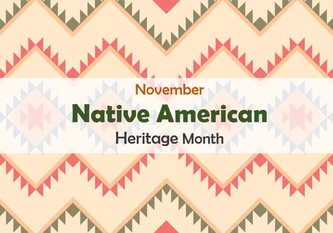
November is Native American Heritage Month and a time to celebrate Native culture and traditions, including those that connect people to the land and promote the use of local foods. Native American Tribes and schools across the country are incorporating traditional food like bison, mesquite flour, wild rice, and ancient varieties of squash and corn into school meals and providing educational activities that teach students about nutrition and Native American food traditions. To date, there are more than 560 tribes recognized by the United States government, each with its own food and agricultural history and culture.
The USDA Office of Community Food Systems would like to highlight four of our Farm to School Grantees that are operating Native farm to school programs.
Santa Fe Indian School
The Santa Fe Indian School, located in New Mexico, was awarded a Farm to School Turnkey Grant in Fiscal Year 2021. They plan to develop partnerships and obtain products from local growers/producers, identify goals for on campus gardening projects, and educate the school community on farm to school practices with a special emphasis on Southwest Native American culture. They are moving in the right direction to provide healthy, tasty, and nutritious meals that will be inclusive of traditional Native American foods while respecting the environment and meeting the dietary needs of their diverse school community.
Cheyenne River Sioux Tribe
The Cheyenne River Sioux Tribe (CRST) is located in South Dakota on the Cheyenne River Reservation, and in Fiscal Year 2020 was awarded a Farm to School Planning Grant. The CRST Farm to School Program provides locally sourced beef and buffalo to the National School Lunch Programs in the five schools located on the Cheyenne River Sioux Reservation. The project will give local producers the opportunity to make their beef and buffalo available to over 2,200 children who attend schools on the Cheyenne River Sioux Reservation. The Farm to School Program’s mission is to improve communities’ access to nutritious, affordable, locally grown, culturally significant foods by linking local food production to local needs.
|

Quapaw Tribe of Oklahoma
The Quapaw Tribe of Oklahoma and the Quapaw Public School District were awarded a Farm to School Planning Grant in Fiscal Year 2019. They developed a planning project that impacts more than 600 students within their community. Their project included convening a Farm to School Organization Committee to develop and implement a tool to assess the community’s need and readiness for a farm to school program, conducted a student-led research project at the Quapaw High School to identify obstacles, resource gaps, and potential strategies to overcome barriers to launching farm to school activities, and used the Farm to School Planning Toolkit to compile and analyze data collected from their activities.
Red Cloud Indian School
Red Cloud Indian School serves Lakota students on the Pine Ridge Reservation in Pine Ridge, South Dakota. Awarded a Farm to School Implementation Grant in Fiscal Year 2020, they are using season extension techniques to continue to produce food through the winter at their established school farm and expanded school-based program in order to allow student participation throughout the school year and expand the opportunity to teach nutrition and agricultural lessons in the classroom.
|

First Nations Development Institute is currently hosting the second season of their Native Farm to School Webinar Series. Cultivating cultural and medicinal harvest camps, Tribal food sovereignty, and developing a Native farm to school program - these are only a few of the topics that will be covered throughout the series. The next webinar in the series will take place on December 2nd.
Register for upcoming webinars and download slides or recordings from the webinars you missed at: https://www.firstnations.org/webinars/native-farm-to-school-webinar-season-2/.
|

Kentucky's top Junior Chef wins at Southeast Region competition
Henderson County High School’s Junior Chef team cooked up a win at the U.S. Department of Agriculture’s Southeast Region Junior Chef competition in October. The Southeast Region Junior Chef competition pits the champions of states in the southeastern United States in a cook off to demonstrate their culinary arts skills to create standards compliant recipes using local agricultural food products. The Henderson County team, “The Colonel’s Cookin’ Crazies,” prepared its Colonel’s Crazies Pork Burger with Colonel’s Spicy Slaw. The Southeast Region Junior Chef competition teaches students about agriculture, marketing, organization, teamwork, and community involvement. The competition, which was virtual this year, featured teams from Kentucky, Tennessee, South Carolina, and North Carolina.
Read the full article HERE!
|
Community Food Projects Competitive Grants Program
National Institute of Food and Agriculture (NIFA)’s Community Food Projects (CFP) is funding two grants: (1) Community Food Projects (CFP) and (2) Planning Projects (PP). CFP supports the development of projects with a one-time infusion of federal dollars to make such projects self-sustaining. The purpose of the PP is to complete a plan towards the improvement of community food security. For more information and an outline of primary goals, read the CFP funding opportunity announcement.
The team at FRESHFARM are offering fun, high energy instructional videos for teachers and students that have been designed to be taught throughout the school year across grades from Pre-Kindergarten through 5th grade. The FoodPrints Curriculum is free lessons that have been sequenced according to seasonal topics and adaptable for a range of uses from embedded programming, to supplementing classroom education, to garden-based learning.
Check out the FoodPrints new curriculum video series!
FY 2022 Farm to School RFA – Applications Due January 10th, 2022
The fiscal year (FY) 2022 Farm to School Grant Program Request for Applications (RFA) is open! The Grant RFA can be found online HERE. Additional resources for the FY 2022 Farm to School Grant application are now available on the "Related Documents" tab of the Grants.gov page. Visit Grants.gov for templates to assist with the proposal narrative and budget narrative sections of the application, plus a fillable priority declaration checklist!
Be sure to visit the Resources for Grant Applicants page to access other helpful resources when applying for a Farm to School Grant. These links are for our webinars that provide specific assistance on applying:
Farm to School Grant Overview and How to Apply | Food and Nutrition Service
Developing and Writing a Successful Application | Food and Nutrition Service
At White House Tribal Leaders Summit, USDA Announces New Initiatives Serving Indian Country
In an historic White House Tribal Leaders Summit, U.S. Agriculture Secretary Tom Vilsack announced several new initiatives that expand USDA’s commitment to serving Indian Country through equitable policies and programs. Programs that have been introduced include: The USDA Indigenous Food Sovereignty Initiative; USDA Commits to Expanding Tribal Self-Determination; new USDA-DOI Tribal Treaty Database; and the new USDA Hall of Tribal Nations.
Learn more about it HERE!
USDA National Institute of Food and Agriculture Invests in Youth in Underserved Communities
The USDA’s National Institute of Food and Agriculture (NIFA) recently announced their investment of over $3.5 million to support educational awareness of food, agriculture, and farm safety for youth in underserved communities. Learn more about it HERE!
All children aged 5 and older are now eligible to get vaccinated. This means 28 million kids ages 5 through 11 can now get the lifesaving protection of a vaccine. The vaccine is safe and effective, has undergone rigorous review, and has been authorized by FDA and recommended by CDC after thorough testing for safety in thousands of children. Vaccines are starting to arrive in locations across the country now as the program ramps up and will be available in more than 20,000 sites, including pediatricians and family doctors’ offices, pharmacies, community health centers, children’s hospitals, and community-based sites and schools.
Guardians will be able to find available vaccines at their health care provider, local pharmacy, or visiting the website Vaccines.gov - Find COVID-19 vaccine locations near you

National Farm to School Network (NFSN) is looking to hire three new communications positions to maximize the impact of the farm to school movement. They are looking for individuals who share their commitment of racial and social equity and embody values of gratitude, liberation, and collaboration.
|
|